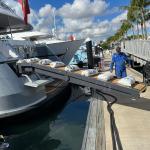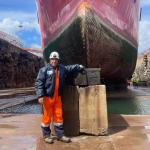Implementing Multi-Factor Authentication (MFA) in a Vessel: Enhancing Maritime Cybersecurity
As technology becomes more integrated into the maritime industry, vessels increasingly rely on connected systems for navigation, communication, and operations. This digital transformation, however, also exposes vessels to a higher risk of cyberattacks, making cybersecurity a top priority. One of the most effective ways to protect vessel systems and sensitive data is through the implementation of Multi-Factor Authentication (MFA). MFA adds an extra layer of security by requiring multiple forms of verification, reducing the likelihood of unauthorized access.
Why MFA is Critical for Maritime Cybersecurity
Traditionally, cybersecurity aboard vessels relied on simple password-based systems to control access. However, passwords alone are increasingly vulnerable to threats such as phishing, password cracking, and brute-force attacks. The consequences of compromised systems on a vessel can be severe, ranging from unauthorized access to navigation or control systems to exposure of sensitive company or passenger data.
MFA mitigates these risks by adding an additional layer of authentication, ensuring that even if a password is compromised, attackers still face another security hurdle. This can be especially important in the maritime industry, where crews often work in remote environments with limited oversight, and the consequences of a cyberattack can be magnified.
Steps to Implement MFA in a Vessel
Implementing MFA in a vessel involves a series of steps, from evaluating the right MFA solution to managing user access in real-world maritime conditions. Here’s a guide on how to achieve this:
1. Assess Your Vessel’s Systems
Start by conducting a thorough audit of your vessel’s digital infrastructure. Identify all key systems that require access controls, such as:
- Navigation and control systems (e.g., ECDIS, radar, and dynamic positioning systems).
- Ship management software.
- Communication networks (VSAT, GMDSS, satellite communications).
- Crew and passenger access portals.
- Administrative networks used for reporting and monitoring.
Determine where MFA would be most beneficial, particularly for systems that control vessel navigation or contain sensitive operational or financial data.
2. Choose an MFA Solution Compatible with Maritime Environments
Not all MFA solutions are created equal, and the maritime environment presents unique challenges, such as limited internet connectivity, remote locations, and often fluctuating communication links. The ideal MFA solution must work in these constrained environments and continue functioning with minimal downtime.
When choosing an MFA solution for your vessel, look for:
- Offline Authentication Options: Solutions that can operate in environments with limited or no internet access. Some MFA services offer hardware tokens or smartphone-based apps that can generate authentication codes without the need for constant connectivity.
- Compatibility with Existing Systems: The MFA service should be compatible with the vessel’s current operating systems, networks, and software.
- Ease of Use for Crew: Ensure that the MFA process is simple and doesn’t interfere with daily operations. Vessels operate in fast-paced environments, so the MFA must strike a balance between security and usability.
3. Deploy and Configure MFA
Once an MFA provider is selected, the next step is to deploy and configure it across the vessel’s systems. This usually involves:
- Installing MFA software or integrating with existing systems.
- Creating user accounts and assigning appropriate access levels to crew members and other personnel.
- Configuring authentication methods (e.g., passwords, biometric data, or one-time passcodes).
- Ensuring offline access for critical operations where continuous internet is unavailable.
4. Train Crew Members
Training is critical to the successful implementation of MFA. Crew members need to understand how MFA works and how to use it effectively. Provide instructions on:
- Setting up personal MFA devices (such as smartphones or hardware tokens).
- Generating one-time passcodes.
- Managing recovery options if a device is lost or inaccessible.
- Reporting any suspicious activities or difficulties with authentication.
5. Monitor and Update MFA Systems
MFA systems, like all security measures, require continuous monitoring and periodic updates. Establish a process for:
- Monitoring access logs for signs of unauthorized access attempts.
- Regularly updating MFA software and policies to stay ahead of emerging cyber threats.
- Reviewing user permissions to ensure that access is only granted to authorized personnel.
Popular MFA Solutions for the Maritime Industry
When selecting an MFA service for use aboard a vessel, it's important to consider solutions that cater to industries with similar challenges, such as aviation, logistics, or remote industrial environments. Here are some popular MFA solutions commonly used in maritime and related industries:
1. Duo Security (Cisco)
- Features: Duo Security is a flexible and widely used MFA platform that offers authentication via push notifications, SMS, phone calls, and hardware tokens. It is also known for its offline authentication capabilities, making it suitable for vessels with limited internet connectivity.
- Advantages for Vessels: Duo’s ability to operate with varying levels of internet connectivity makes it ideal for maritime settings. Additionally, its ease of integration with existing shipboard systems adds to its appeal.
2. Google Authenticator
- Features: Google Authenticator is a simple, widely-adopted MFA solution that provides time-based one-time passcodes (TOTP). It works well offline and is easy to set up on personal devices.
- Advantages for Vessels: Google Authenticator is a cost-effective solution that requires minimal resources to deploy. Its offline functionality makes it well-suited for vessels with intermittent internet access.
3. Microsoft Authenticator
- Features: Microsoft Authenticator is similar to Google Authenticator but offers integration with Microsoft 365 and Azure systems. It supports push notifications, TOTP, and biometric authentication.
- Advantages for Vessels: Many vessels already use Microsoft services, making this a seamless addition to existing systems. Its offline capabilities and compatibility with a wide range of shipboard applications make it a strong choice.
4. Yubico (YubiKey)
- Features: Yubico offers physical hardware tokens (YubiKeys) that provide an additional layer of security. These tokens can generate authentication codes without requiring a network connection and are highly durable.
- Advantages for Vessels: YubiKeys are ideal for the harsh conditions onboard vessels. They are weather-resistant and can work offline, making them perfect for secure, remote access on ships.
5. RSA SecurID
- Features: RSA SecurID offers a range of authentication solutions, including hardware tokens, biometric recognition, and SMS-based authentication. It’s known for its high level of security and widespread use in industries requiring robust protection.
- Advantages for Vessels: RSA’s hardware tokens and robust authentication infrastructure make it a reliable choice for vessels, especially for protecting critical systems like navigation and communication networks.
Conclusion
The maritime industry is evolving, and with it, the need for enhanced cybersecurity is becoming more apparent. Implementing Multi-Factor Authentication aboard vessels is a key step in protecting against unauthorized access and reducing the risk of cyberattacks. By selecting the right MFA solution, providing adequate training, and ensuring seamless integration into existing systems, vessel operators can significantly enhance their cybersecurity posture while keeping operations smooth and secure.




